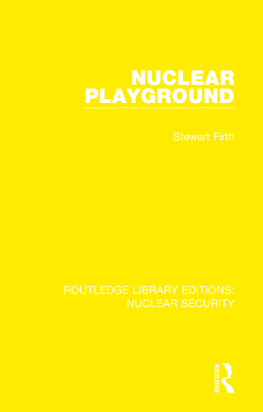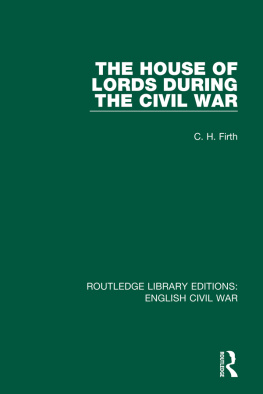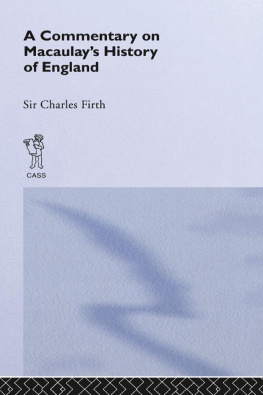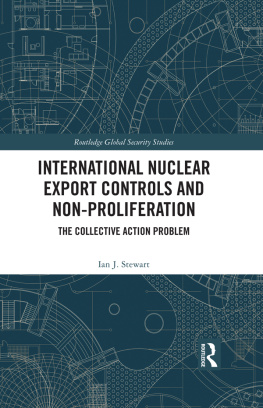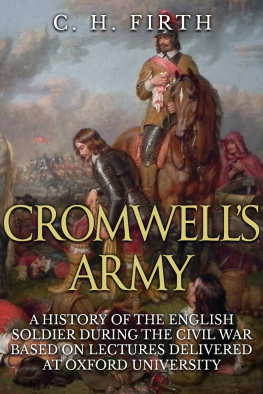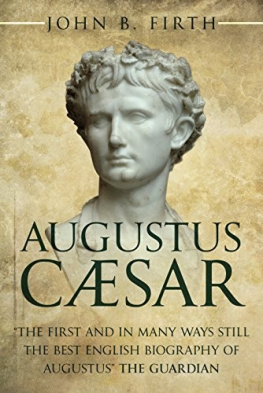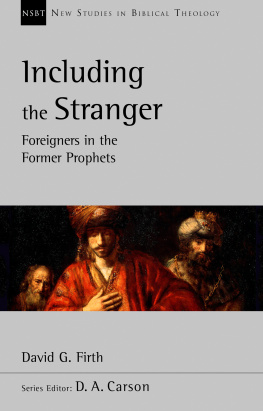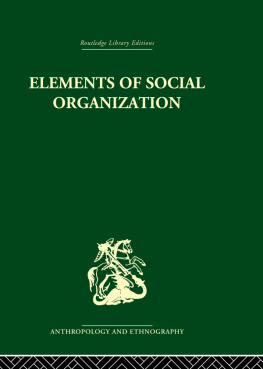ROUTLEDGE LIBRARY EDITIONS: NUCLEAR SECURITY NUCLEAR PLAYGROUND
Volume 25
NUCLEAR PLAYGROUND
First published in 1987 by Allen & Unwin
This edition first published in 2021
by Routledge
2 Park Square, Milton Park, Abingdon, Oxon OX14 4RN
and by Routledge
52 Vanderbilt Avenue, New York, NY 10017
Routledge is an imprint of the Taylor & Francis Group, an informa business
1987 Stewart George Firth
All rights reserved. No part of this book may be reprinted or reproduced or utilised in any form or by any electronic, mechanical, or other means, now known or hereafter invented, including photocopying and recording, or in any information storage or retrieval system, without permission in writing from the publishers.
Trademark notice: Product or corporate names may be trademarks or registered trademarks, and are used only for identification and explanation without intent to infringe.
British Library Cataloguing in Publication Data
A catalogue record for this book is available from the British Library
ISBN: 978-0-367-50682-7 (Set)
ISBN: 978-1-00-309763-1 (Set) (ebk)
ISBN: 978-0-367-53325-0 (Volume 25) (hbk)
ISBN: 978-1-00-308142-5 (Volume 25) (ebk)
Publishers Note
The publisher has gone to great lengths to ensure the quality of this reprint but points out that some imperfections in the original copies may be apparent.
Disclaimer
The publisher has made every effort to trace copyright holders and would welcome correspondence from those they have been unable to trace.
Nuclear Playground

Sign at a site for the burial of nuclear waste from the American testing program, Enewetak Atoll, Marshall Islands. (Photo: Ron Jett)
Nuclear Playground
Stewart Firth
ALLEN & UNWIN
Sydney London Boston
For Bill and Jan
Stewart George Firth 1987
This book copyright under the Berne Convention.
No reproduction without permission. All rights reserved.
First published in 1987
Allen & Unwin Australia Pty Ltd
8 Napier Street, North Sydney, NSW 2060 Australia
Allen & Unwin New Zealand Limited
60 Cambridge Terrace, Wellington, New Zealand
George Allen & Unwin (Publishers) Ltd
18 Park Lane, Hemel Hempstead, Herts HP2 4TE England
Allen & Unwin Inc.
8 Winchester Place, Winchester, Mass 01890 USA
National Library of Australia
Cataloguing-in-Publication
Firth, Stewart, 1944
Nuclear playground.
Bibliography.
Includes index.
ISBN 0 04 172009 1 (pbk.).
1. Atomic bombTesting. 2. Atomic bombAustralia
Testing. 3. Atomic bombMoruroa AtollTesting.
I. Title.
623.45119
Set in 1 pt Palatino by Setrite Typesetters, Hong Kong Printed by Dah Hua Printers, Hong Kong
This book represents part of the outcome of a research project generously funded since 1984 by the Australian Research Grants Scheme and Macquarie University.
I owe much to many people for help. I would like to thank Geoff Adlide, Jim Anthony, Dirk Ballendorf, Roger Clark, Brian Cosgrove, Faith Doherty, Bill Fisher, Murray Goot, Renee Heyum, Fran Hezel, Stuart Inder, Giff Johnson, Peter Jones, Bemie Keldermans, Kathy Kesolei, Brij Lai, John Langmore, Leonard Mason, Norman Meller, Nancy Morris, Warren Osmond, Karen Peacock, Michelle Sheather, Suliana Siwatibau, Beverley Symons and Floyd Takeuchi. I greatly valued the comments of Maynard Davies, Jan Gammage, Bob Kiste, Dennis ORourke and Ellen Whelan on earlier versions of the book. Kathie Smith drew the maps. Helma Neumann not only typed the book with extraordinary skill and speed; she also offered endless encouragement. Without Bill Gammage the book would never have been finished; without John Iremonger, the publisher, it would never have been started. Beverley, Verity and Charles Firth cheerfully accepted my preoccupation with writing about the nuclear issue.
Note on spelling
I have used the most recent spellings of island names, which nevertheless appear in earlier forms in some quotations: Belau rather than Palau; Enewetak, not Eniwetok; Kosrae, not Kusaie; Moruroa, not Mururoa; Pohnpei, not Ponape; UJelang, not UJilang.
Note on currency
All dollars mentioned in the text are US dollars.

The nuclear Pacific, past and present, showing sites of nuclear bomb tests and major missile trajectories. The Americans and British tested until the early 1960s, leaving behind a radioactive legacy. The French still explode bombs at Moruroa Atoll. American, Soviet and Chinese missiles are fired to a variety of splashdown points in the Pacific.
World War III could start in the Pacific. Long regarded by the USA as an American lake, the Pacific is now a focus of competition between the superpowers. With their great arc of bases from Alaska to Japan, Guam, the Philippines and Diego Garcia in the Indian Ocean, the Americans try to keep the Soviets bottled up on the Pacific coast of the USSR, where narrow straits offer the only access to open ocean. But the Soviets now have a major new naval base at Cam Ranh Bay in Vietnam and are steadily adding to their military forces. This development has sparked a response from the other side. The Americans are determined not to be outdone. They are planning more urgently for war in the Pacific, adding to their own mighty arsenal in the region and taunting the Soviets with aggressive surveillance and military exercises. The Soviets do the same. Both superpowers have nuclear submarines, nuclear bombers and nuclear cruise missiles. Both maintain a web of command and control posts. The navies of both countries carry nuclear weapons. Strategists on both sides call for more weapons to keep the balance.
What is the purpose of this extraordinarily risky nuclear rivalry? The war planners answer in words which are designed to keep us confused and powerless. They talk of theater nuclear exchange on terms favourable to war termination and creating a viable and credible nuclear deterrent. The true meaning is simple and horrifying: the superpowers have equipped themselves with bombs which will put an end to human history if they are used; and because the logic of nuclear deterrence is that a threat must never be empty, the superpowers seriously intend to push the nuclear button if necessary. The Pacific could be where they first do so. Of the five nuclear powers, threethe USA, the USSR and Chinalaunch missiles into the Pacific for test purposes; twothe USA and Britainused to explode nuclear bombs there but have long since stopped; and one, France, continues to test its nuclear bombs in one of its Pacific colonies. Pacific Islanders have long resented the use of their ocean as a nuclear playground. They now fear that it might become a nuclear battleground.
To go to the atolls of the Pacific or to the deserts of Australia is to be reminded that nowhere on earth is remote. These are the places where the Americans and the British exploded nuclear bombs, and, in the case of Moruroa Atoll in French Polynesia, where the French still do. The nuclear bomb men have always assumed that atolls and deserts are a long way from anywhere. But they are wrong. Nuclear explosions in the atmosphere, which occurred frequently in the Pacific Islands between 1946 and 1975, were global in effect. The winds and seas carried radioactive contamination over vast areas of that fragile ecosphere on which we all depend for our survival and which we call the earth. In preparing for war, we were poisoning our planet and going into battle against nature itself. The atmospheric tests, now stopped, were like a miniature rehearsal for nuclear war itself, a symbol of our inability to find refuge. The nuclear age, we discovered, had bound together the destinies of all humankind. For more than a decade now France has pounded Moruroa Atoll with nuclear explosions underground, assuring us, as the atmospheric testers used to assure us, that all is well. But we have grown sceptical. Too many military men have told too many lies for too long. Like radiation itself, stories about contamination leak out from Moruroa. And the French never answer the obvious question: if underground testing is so safe, why not do it in France?



